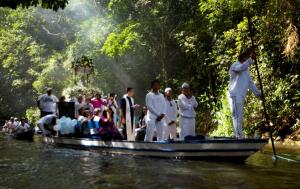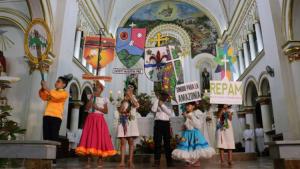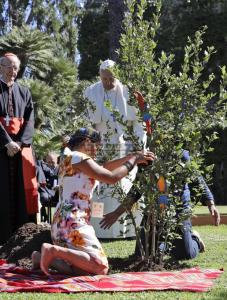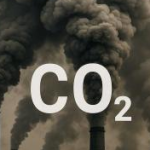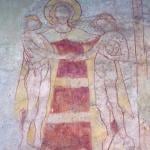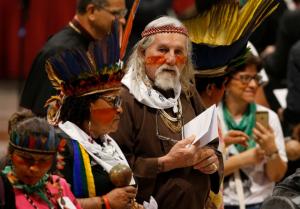
The Synod of Bishops for the Amazon opened Sunday with a Mass and a call from Pope Francis to “fight fire with fire.” The fires include nearly 80,000 burning in the Amazon rainforest, inflammatory moves in some Church circles in opposition to Pope Francis and the synod, and the fire of the Gospel.
“Jesus did not come to bring a gentle evening breeze, but to light a fire on the earth, ”the Pope said. He could have extended the quote from Luke to where Jesus says he came to sow division, in a household of five, “three against two and two against three.” (Luke 12:52) That household, at the moment, is the Church. Pope Francis’ remarks didn’t back down from or avoid conflict in the Church.
The pope raised up the Amazon and its peoples as the central concern, but you could see internal Church politicking here:
The fire of God is warmth that attracts and gathers into unity. It is fed by sharing, not by profits. The fire that destroys on the other hand, blazes up when people want to promote only their own ideas, form their own group, wipe out differences in the attempt to make everyone and everything uniform.
An anti-Francis element excoriates the synod and its Preparatory Document for the way it affirms and finds God working in the experiences and indigenous cultures of the peoples of the Amazon. The pope doesn’t name his target, but the ones who smother the “fire of the Spirit” under the “ashes of fear and concern for defending the status quo” could as easily be traditionalists inside the Church as operatives in governments and exploiting markets.
Traditionalist objections to the synod
This article in The Economist lays out the objections of the traditionalists. They charge that the Preparatory Document “verges on paganism” by idealizing creation. They imagine that to learn from “indigenous traditions, healing practices, and lore” is to abandon Christian truth. And they allege that the document “downgrades the human species by presenting it as simply one more link in an ecological chain.”
The economist article may have identified a less theological motivation for many Americans among the traditionalist camp. They are “unhappy with the radical economic view that underpins the synod: one that blames greedy extractive industries and agri-businesses based in the northern hemisphere for the felling and burning of trees whose existence is crucial to the planet.”
Finally, attacking traditionalist objects head-on, the article asks:
How do we interpret the fact that historically Christian cultures have behaved unwisely, as the document asserts, and must relearn wisdom from peoples untouched by Christianity?
The Preparatory Document
I read Part II of the Preparatory Document, looking especially for the theology that traditionalists objected to. The title of this part is “Discernment, towards a Pastoral and Ecological Conversion.” (Disclosure: If it’s creation spirituality that animates this section, then that’s a plus in my view.) The following is some of what I found.
Section 7, not titled
- The document starts out rather traditionally. It notes “the harmonious relationship between God, humanity, and the cosmos” in the Garden of Eden. (#7) All creation, not just humanity, is wounded by sin.
- But part of the cure for that world God has placed within creation itself. “[T]he germ of the promise and the seed of hope are planted within wounded creation.” This document finds God working even outside God’s chosen people, outside the Bible, and even outside humanity: “Soil, water … everything is a caress of God.” The good creation cooperates with the Father’s Providence. Providence “reaches its climax in the mystery of the Incarnation of the Son of God.”
Section 8, Proclaiming the Gospel of Jesus in the Amazonia: Social dimension
- In the next section the document details a social dimension to salvation. There’s a “profound connection between evangelization and human advancement.” Evangelization means “making the Kingdom of God present in the world” and striving “against social inequalities and the lack of solidarity….”
- The people of the Amazon were never strangers to the Church’s mission of evangelization. “[T]he interconnectivity between human life, ecosystems, and spiritual life was, and continues to be, apparent to the vast majority of ‘the Amazon’s] inhabitants.” The cry of the poor and the earth, in short, “the cry of the Amazonia to the Creator is similar to the cry of God’s People in Egypt.”
Section 9, Proclaiming the Gospel of Jesus in the Amazonia: Ecological dimension
- There is a link between “the social and the environmental spheres.” We humans “are part of the ecosystems which facilitate the relationships that give life to our planet.” (Could this be the “downgrading” of the human species traditionalist don’t like?)
- This section praises the threatened “rich and diverse ancestral worldviews of [the Amazon’s] populations.” This wisdom challenges us to an “ecological conversion.” We must be “aware of how our lifestyles—and the ways we produce, trade, consume, and discard—affect the life of our environment and our societies.”
- Personal conversion is not enough. We need also “structural change, expressed in social habits, laws, and corresponding economic programs.” This also has something to do with evangelization. That’s especially true “considering the depth with which the Spirit of God penetrates nature and the hearts of individuals and peoples.” (I like this last thought; traditionalists, perhaps, not so much.)
Section 10, Proclaiming the Gospel of Jesus in the Amazonia: Sacramental dimension
- There’s a “strong headwind that comes from the power of sin.” I think traditionalists would like that formulation. Perhaps they wouldn’t like the way the document sees this wind “in social and environmental destruction.” This is the paragraph that introduces grace and evangelization’s “sacramental dimension.”
- “The universe unfolds in God, who fills it completely. Hence, there is a mystical meaning to be found in a leaf, in a mountain trail, in a dewdrop, in a poor person’s face.” A contemplative gaze at this reality “can grasp the presence and action of God in all creation and in all history.”
- Sacraments take up this graced nature to give us supernatural life. Therefore, the document insists on “inculturation” of the sacraments. In the Amazon they must reflect the conditions of life in the Amazon. Amazonian peoples have traditional water rites that can grace the sacrament of Baptism. The Blood of Christ in the Eucharist is joined by “the blood of so many men and women that has been shed – bathing the Amazonian lands for the good of its inhabitants and of the territory.” This seems to be a reference to the ones Pope Francis calls martyrs. Many have been killed for their defense of the Amazon.
Section 11, Proclaiming the Gospel of Jesus in the Amazonia: Ecclesial-missionary dimension
- This section insists on listening to the Amazonian peoples as an intrinsic part of the Church mission work. It ends Part II by looking ahead to the controversy over ordaining married men (viri probati). The Eucharist is simply not available in much of the Amazon much of the time. The Church must listen to “the cry of thousands of communities deprived of Sunday Eucharist for long periods of time.”
The preparatory document is a work in progress. The synod’s 184 voting bishops, one voting lay brother, and, unconscionably, no voting women will undoubtedly have much to say.
Image credit: National Catholic Reporter



